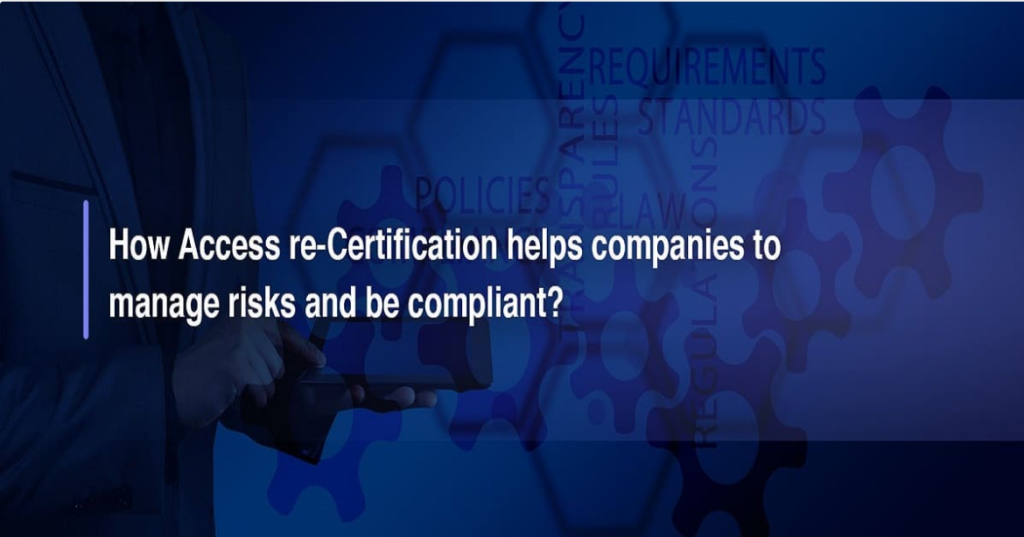
While a provisioning system enables enterprises to add, modify and delete user accounts on various business applications, it is also imperative for organizations to implement access parameters as per the business requirement. However, the challenge is to select the right access conditions and ensuring that employees are given only the appropriate amount of access to conduct their work. As the provisioning system is based on certain configurations and in case of any error in the rules, the user provisioning will also be attributed incorrectly. Thus, the only method to verify that the provisioning is being provided as per the regulations, auditing of the functions needs to be undertaken through the process of ‘re-certification.’
Understanding access recertification
It is a process through which user access rights are collected and thereafter, a comparative analysis is being conducted to understand if the access rights providers are acceptable or required. Such an audit is undertaken through the analysis of the system providing feedback loop, to make sure that the provisioning system is granting right access. However, such a process is not easy to execute, as enterprises need to implement various pre-defined stages for implementation of the entire recertification process without any errors. Further, to meet numerous policies, regulations, and maintain the privacy and integrity of enterprise information and identities, it is essential to keep a check on the access rights and privileges provided to the users.
Need for access recertification
To ensure agility, and security, apart from adhering to compliance issues, it is important for enterprises to document the access control information. With access recertification, it is being ensured that no users have undue privilege to access resources beyond their set roles. Further, the major driver behind IAM access re-certification is to assure that enterprises are able to meet the numerous compliance and regulatory policies, such as financial information integrity through SOX (Sarbanes-Oxley), Health Insurance Portability and Accountability Act (HIPAA) in the healthcare sector, GDPR data protection law, and other privacy regulations on access control and certification.
Compliance resolution
The core of most regulations is to safeguard the privacy and integrity of data, requiring enterprises to stress user access. This has led to creating stringent access policies across enterprise systems, data and apps. With the implementation of IAM access re-certification, enterprises are able to meet HIPAA, SOX, and other industry-specific compliances, required for monitoring access to applications, systems, and data. It offers a clear picture of who has the right access to what and what should be done when access is not right. Here’s how:
- Curbing unauthorized access to minimize risks associated with security and compliance
- Automating implementation of Segregation of Duties (SoD) policy across the enterprise to ensure compliance
- Accelerating the process to reduce the time taken for certifying access and remediating violations
- Documenting certification effort to enable companies to comply with auditors requirement for sharing evidence
- Reducing manual intervention of gathering data for auditing and compliance purposes through report generation facility on policy violations, certification status and other information
- Defining business roles on a regular basis to assign right access as per the compliance requirements
Insider threat prevention
Along with regulatory compliances, enterprises also need to focus on protecting their assets from threats posed by malicious insiders, which may result into fraud, data breach or unauthorized transactions. Further, orphan or dormant accounts may result in providing an entry to hackers, unless access provisions are audited on a regular basis. Access re-certification minimizes the chances of inappropriate access privileges, especially the ones provided to employees or partners, to ensure elimination of insider threats, while securing the enterprise data and brand reputation. Here’s how:
- Integrating source and target systems with IAM functions to create a centralized data repository
- Automating access audits to eliminate manual errors
- Implementing web-based interface for better approval and rejection of accesses
- Creating list of reviewers and users for re-certification
Risk management
While security is critical for reducing business liability and losses, it is also imperative to focus on a balanced approach to enable businesses to achieve their goals. Thus, along with blocking inappropriate users from accessing the systems to mitigate security risks, enterprises also need to allow legitimate users access resources. With access to re-certification, enterprises are able to expand and grow within a secure and agile environment. Due to open access, coupled with the right access control to resources, re-certification enables the right people to access applications and systems, while barring malicious entities. Here’s how:
- Scheduling and monitoring re-certifications to ensure completion of reviews on time
- Automating the detection of current and possible policy violations, especially in vital areas such as SoD and privilege accounts
- Tracking modifications or revocations of access
- Alerting about current or possible policy violations to the access administrators for timely remediation
In order to ensure creating an accountable, compliant and holistic enterprise, undertaking access re-certification at least annually is a critical process. Be it any application – SailPoint, ServiceNow, AD, Cerner, Epic, Kronos, McKesson, HR System, SAP, Okta, CyberArk, access re-certification enhances the accuracy of access validation while providing a formal process for audit purposes.

